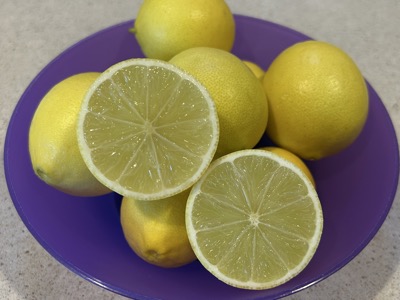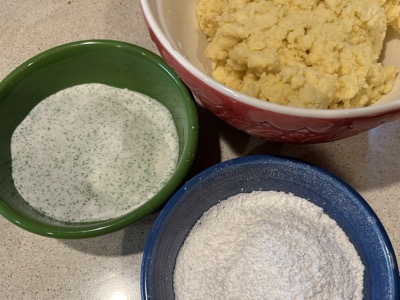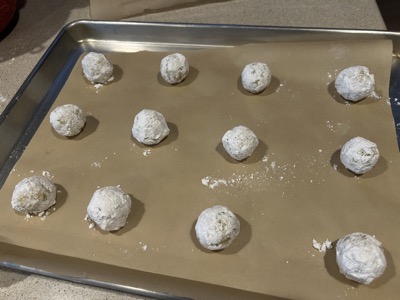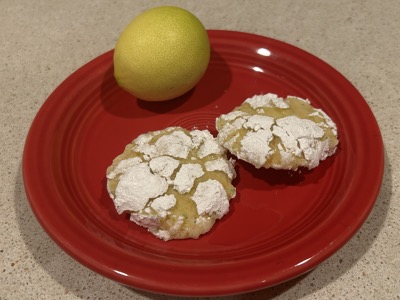
Recipe: Ripe fruit is less acidic, more juicy than green limes

Crinkle cookies made with ripe limes are ready for a party. Kathy Morrison
My little Meyer lemon tree dropped all its developing fruit in last July's heat wave. But the Bearss lime tree, protected under a pergola, seemed unbothered, and now, five months later, has the most gorgeous crop. In the past few weeks, almost all of the limes have ripened, transforming from classic green to a bright yellow-green.

I'm never ready for this switch, immersed as I usually am this time of year in baking with cinnamon and ginger and chocolate. But I hit on a recipe to use several of these limes, and I'm thrilled with the results, which are headed to a party.
When ripe, limes are juicier and less tart, more floral than their green selves. They are still limes, just enhanced. I stumbled on an Epicurious story from 2016 headlined "Are Yellow Limes Better Than Green Ones?" The answer, for baking anyway, is "yes."
The best explanation in the story comes from Karen Beverlin of FreshPoint, a produce distributor: "A ripe [yellow] lime is to a regular lime as a Meyer lemon is to a regular lemon," she says.
So why do we see green limes in the supermarket? As with commercial tomatoes, ahem, they travel better when they're still hard and green. Great for margaritas and grilled shrimp, though.
So back to this cookie recipe, which I've adapted from several lemon/Meyer lemon versions. I snuck a sprinkle or two of green decorating sugar into the rolling sugar -- so there is some festive green in these cookies.
If you don't have ripe limes, try this recipe with regular ones (you may need one or two more) or with either type of lemon.
Baking notes: Allow at least two hours for the dough to chill; overnight is even better. And removing the cookies from the oven when they're slightly underbaked makes them wonderfully tender and chewy. If you prefer cakey cookies, continue baking until the bottoms just start to brown; the cookies won't flatten as much.
Also, the double sugar rolling is a technique I learned awhile back: The granulated sugar keeps the layer of confectioner's sugar from melting off the cookie. That's how you get those gorgeous crinkly clumps.
Ripe lime crinkle cookies
Makes 30 to 36 two-inch cookies
Ingredients:
1 cup granulated sugar
1 generous tablespoon grated lime zest (from 3 or 4 ripe limes)

1/2 cup (1 stick) unsalted butter, melted and cooled
1 egg, room temperature
1 egg yolk, room temperature
1/2 teaspoon vanilla extract
3 tablespoons fresh ripe lime juice
2 cups all-purpose flour
3/4 teaspoon kosher salt
1/2 teaspoon baking soda
For rolling:
1/3 cup granulated sugar (include some green sugar if desired)
1/2 cup or more confectioner's sugar
Instructions:
Place the 1 cup granulated sugar in a large bowl. Add the lime zest, and rub the sugar and zest together with a spatula, spoon or fingers until thoroughly combined.
Then stir in the melted butter, the egg and egg yolk, and the vanilla until combined. Whisk in the lime juice.

In a medium bowl, whisk together the flour, salt and baking soda. Stir the flour mixure into the butter-sugar mixture about one-third at a time until fully incorporated. Cover the bowl and refrigerate for at least 2 hours.
When ready to bake, heat the oven to 325 degrees. Cover baking sheets with parchment paper.
Place the 1/3 cup granulated sugar in a small bowl, and the confectioner's sugar in another bowl.
Using a tablespoon or a medium cookie scoop, scoop out a rounded mound of dough and roll it into a ball. Roll the ball first in the granulated sugar, then in the confectioner's sugar. Place it on a prepared cookie sheet, and continue with the rest of the dough, spacing the balls 2 inches apart.
Bake the cookies until cracks form and the edges are set but not brown, about 12 minutes if using insulated cookie sheets, about 10 minutes if using non-insulated baking sheet. (Check the bottom of one cookie to make sure it is not browning.)
Remove the cookie sheet to a cooling rack and allow cookies to cool on the pan. They will deflate a little.

Store cookies in an airtight container if not serving soon.
Comments
0 comments have been posted.Sacramento Digs Gardening to your inbox.
Food in My Back Yard Series
May 6: Maintain soil moisture with mulch for garden success
April 29: What's (already) wrong with my tomato plants?
April 22: Should you stock up on fertilizer? (Yes!)
April 15: Grow culinary herbs in containers
April 8: When to plant summer vegetables
April 1: Don't be fooled by these garden myths
March 25: Fertilizer tips: How to 'feed' your vegetables for healthy growth
March 18: Time to give vegetable seedlings some more space
March 11: Ways to win the fight against weeds
March 4: Potatoes from the garden
Feb. 25: Plant a fruit tree now -- for later
Feb. 18: How to squeeze more food into less space
Feb. 11: When to plant? Consider staggering your transplants
Feb. 4: Starting in seed starting
Sites We Like
Garden Checklist for week of May 4
Enjoy this spring weather – and get gardening!
* Plant, plant, plant! It’s prime planting season in the Sacramento area. Time to set out those tomato transplants along with peppers and eggplants. Pinch off any flowers on new transplants to make them concentrate on establishing roots instead of setting premature fruit.
* Direct-seed melons, cucumbers, summer squash, corn, radishes, pumpkins and annual herbs such as basil.
* Harvest cabbage, lettuce, peas and green onions.
* In the flower garden, direct-seed sunflowers, cosmos, salvia, zinnias, marigolds, celosia and asters. (You also can transplant seedlings for many of the same flowers.)
* Plant dahlia tubers. Other perennials to set out include verbena, coreopsis, coneflower and astilbe.
* Transplant petunias, marigolds and perennial flowers such as astilbe, columbine, coneflowers, coreopsis, dahlias, rudbeckia and verbena.
* Keep an eye out for slugs, snails, earwigs and aphids that want to dine on tender new growth.
* Feed summer bloomers with a balanced fertilizer.
* For continued bloom, cut off spent flowers on roses as well as other flowering plants.
* Add mulch to the garden to maintain moisture. Mulch also cuts down on weeds. But don’t let it mound around the stems or trunks of trees or shrubs. Leave about a 6-inch to 1-foot circle to avoid crown rot or other problems.